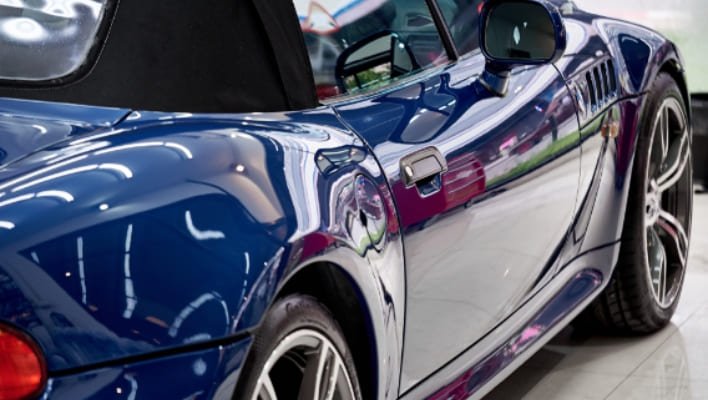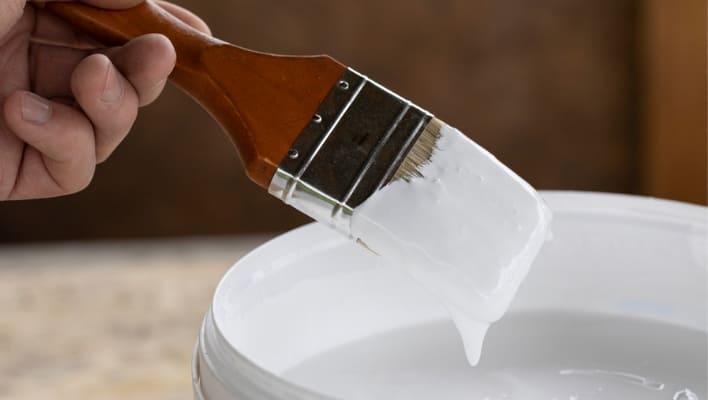Imagine you’ve just completed an intricate woodwork masterpiece, but there’s one more step to complete: applying the ideal protective layer. This is where the question arises – should you proceed with lacquer or polyurethane? These two wood finishes polyurethane vs lacquer often cause confusion due to their similar glossy outcomes. However, they possess distinct characteristics that can significantly impact your creation’s durability and appearance.
Whether you’re an experienced woodworker or a DIYer, the choice between lacquer and polyurethane can make or break your project. Each finish brings its own advantages and drawbacks. We’ll guide you towards an informed decision that ensures your woodwork shines and stands the test of time.
In a Washingtonpost.com article, Fiedler Kawaguchi, an expert in the field, suggests a method to determine the type of finish on furniture. Kawaguchi’s approach involves identifying whether the finish is shellac, a natural resin and a common finish found on antiques. However, it’s relatively rare on modern furniture, which is typically coated with more contemporary finishes such as lacquer, varnish, or polyurethane. This distinction highlights the shift in wood finishing trends over time. It also highlights the prevalence of finishes like lacquer and polyurethane in modern furniture compared to traditional shellac.
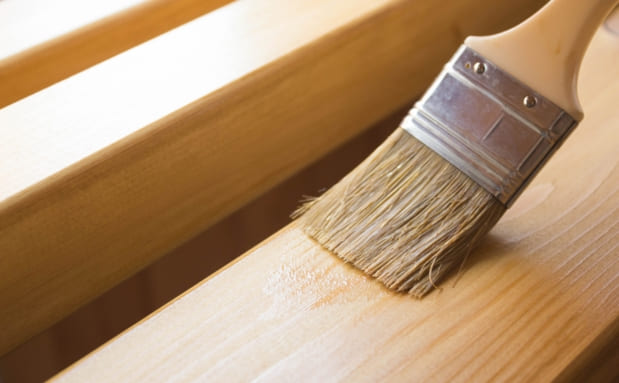
Table of Contents
- Lacquer Vs Polyurethane- Quick Differences
- Polyurethane
- Water-Based Polyurethane
- Oil-Based Polyurethane
- What is polyurethane used for?
- Lacquer
- Acrylic lacquer
- Water-based lacquer
- Nitrocellulose lacquer
- What is lacquer used for?
- Difference Between Polyurethane and Lacquer
- Durability and Protection
- Application and Ease of Use
- Coats/Layers
- Aesthetic Appeal
- Environmental Considerations
- Dry times
- Polyurethane vs lacquer cost
- How to Choose a Right Finish: Lacquer Vs Polyurethane for Different Surfaces
- 1. Dining Room Table:
- 2. Furniture:
- 3. Outdoor Projects:
- 4. Hallways and Entryways:
- 5. Tabletops:
- 5. Cabinets in Kitchens and Bathrooms:
- Final Words On lacquer versus polyurethane
- FAQS On Polyurethane Vs Lacquer
- Is lacquer the same as polyurethane?
- Is polyurethane a lacquer?
- Is lacquer oil-based?
- What does lacquer do?
- Is lacquer better than polyurethane?
- Is lacquer or polyurethane better for furniture?
- What is the hardest clear wood finish?
- Can you lacquer over polyurethane?
- Martina Hitchcock
Lacquer Vs Polyurethane- Quick Differences
The below table provides a quick and comprehensive overview of the key differences between polyurethane and lacquer finishes in terms of composition, durability, application, appearance, repair, environmental impact, historical context, and modern use. It can serve as a handy reference for those looking to choose the most appropriate finish for their woodworking projects.
| Aspect | Polyurethane Finish | Lacquer Finish |
| Composition | Synthetic polymer-based coating | Solvent-based coating (nitrocellulose or acrylic) |
| Types | Oil-based, Water-based | Nitrocellulose, Water-based, Acrylic |
| Durability | Excellent resistance to moisture, chemicals, and wear | Good resistance, but may require more maintenance |
| Application | Thick coat | Thin finish |
| Use | Generally easy to apply, self-leveling properties | Fast drying, requires careful and swift work |
| Method To Apply | Apply with brush | Apply with quality HVLP lacquer sprayer |
| Drying Time | Longer drying times (hours to a day) | Rapid drying (minutes to an hour) |
| Finish Appearance | Various sheen options available (matte to high-gloss) | Classic glossy finish |
| Repairability | Can be sanded and refinished easily | Can be repaired by reapplying more coats |
| Environmental Impact | Water-based options have lower VOC emissions | Solvent-based options emit higher VOCs |
| Historical Use | Common in modern and traditional woodworking projects | Historically used in antique and traditional work |
| Modern Applicability | Suitable for a range of contemporary designs | Mostly used for classic or glossy finishes |
Polyurethane
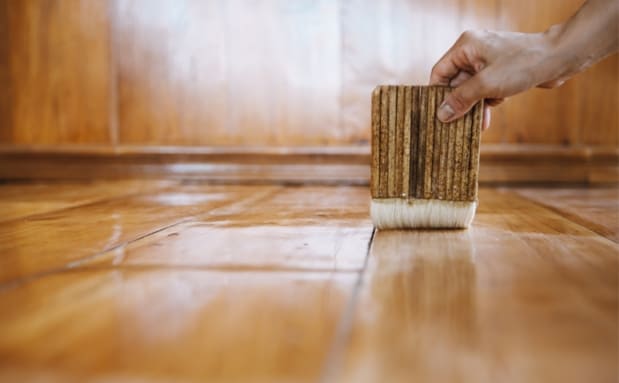
The polyurethane finish is a synthetic, polymer-based finish that provides exceptional durability and protection against various external factors. In contrast to lacquer, polyurethane is a liquid plastic that cures into a thick, durable, and glossy layer. The use of polyurethane in woodworking enhances the longevity of furniture, floors, and other high-traffic areas by resisting water, chemicals, scratches, and dents.
Polyurethane application methods include wiping, brushing, or spraying, with thinning agents sometimes required for spray applications. Due to its thickness, careful application is necessary to achieve an even coating without drips or bubbles.
Want to know more? Here’s a step-by-step guide to spraying polyurethane.
There are two formulations available for this finish: Oil-based and water-based.
Water-Based Polyurethane
1. Non-Toxic and Odorless: Water-based poly boasts a safe application process, free from harsh odors and toxic fumes commonly associated with other finishes.
2. Clear and Durable Finish: Upon drying, water-based polyurethane forms a transparent and resilient barrier that safeguards wood surfaces while retaining their natural beauty.
3. Layered Strength: A single coat may not match the immediate strength of oil-based options, but multiple coats increase its durability.
4. Eco-Friendly Choice: Compared to its oil-based counterparts, water-based polyurethane stands out as a more environmentally conscious choice due to its lower volatile organic compound (VOC) content.
5. Rapid Drying: Water-based polyurethane offers quicker drying times, making it a convenient option for projects with shorter timeframes.
6. Indoor Furniture Application: Its minimal odor and swift drying make it ideal for indoor furniture, allowing multiple coats if necessary.
7. Heat and Chemical Resistance: Despite its benefits, water-based polyurethane may not withstand extreme temperatures or chemical exposure, making it best suited to certain applications.
8. Versatility and Usage: Commonly applied to surfaces like bookcases, desks, and side tables, it’s also favored for finishing hardwood floors.
9. Application Methods: Brushes, rollers, or rags are typically used for applying water-based polyurethane, ensuring smooth and even coverage.
10. Color Preservation: One of its distinct advantages is wood color preservation, unlike some oil-based alternatives that alter its natural appearance.
Oil-Based Polyurethane
1. Durable and Time-Consuming: Oil-based poly is a hallmark among finishing options. Its robustness comes at the cost of slower drying times, often taking up to 24 hours to cure. This extended drying period prompts many seasoned woodworkers to lean towards lacquer or water-based alternatives for quicker results.
2. Enhanced Durability: Notably, oil-based polyurethane outlasts its water-based counterparts due to its thicker consistency. This durability is especially suited to high-traffic surfaces like hardwood floors and stairs.
3. Yellowish Tint and VOC Content: One characteristic of oil-based polyurethane is its tendency to develop a yellowish tint as it dries. However, this can be advantageous for certain wood tones, adding warmth and depth. However, its use comes with a higher content of volatile organic compounds (VOCs), resulting in a strong odor during application.
4. Thorough Ventilation Required: Given its emissions and odor, proper ventilation is crucial when using oil-based polyurethane to ensure a safe and comfortable application environment.
5. Surface Coat and Application: Unlike lacquer, oil-based polyurethane does not penetrate wood. Instead, it forms a durable surface coat. Application can be achieved using a natural-bristle brush or a rag, depending on the desired outcome.
6. Longer Drying Time: Compared to water-based alternatives, oil-based polyurethane demands patience due to its prolonged drying and curing period. Precise adherence to manufacturer’s instructions is essential to optimal results.
7. Compatibility with Paint: Both oil-based and water-based polyurethanes can be applied over latex or acrylic paint, making them versatile choices for various projects.
8. Color Influence: When applied over light paint colors, oil-based polyurethane can introduce a subtle yellow or amber tint, adding character to the finish.
What is polyurethane used for?
Polyurethane creates a durable protective layer on wood surfaces, guarding against wear, scratches, and moisture.
Lacquer
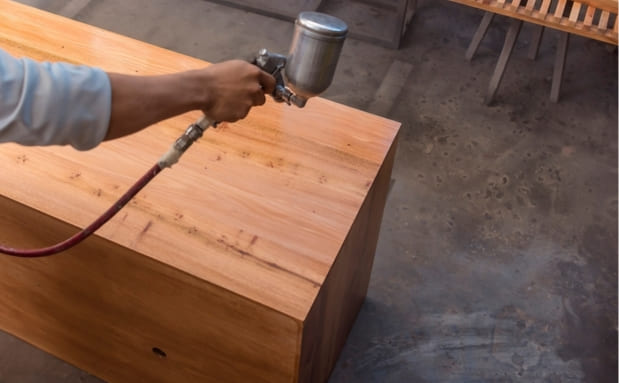
Lacquer, a popular choice among woodworkers, stands out for its ease of application and quick-drying attributes owing to its thin consistency. This finish delivers a sleek, glossy surface while ensuring durability. What makes it special is that it can penetrate deep into the wood, keeping it safe from harm. A protective layer forms upon drying, providing water and heat resistance. Unlike some finishes, lacquer remains immune to yellowing over time. When it’s in liquid form, it seeps into the surface of the wood and gets absorbed, which makes the results last a long time.
Commonly employed for upscale wood furniture, lacquer offers various types, each suitable for distinct projects due to differences in application and benefits.
Acrylic lacquer
Unlike other lacquers, it resists yellowing, maintaining a clear appearance. This variety includes CAB-acrylic lacquer, prized for its flexibility and reduced brittleness. It’s really good at resisting wear and scratches, although it’s more expensive than other stuff. Used predominantly on lighter woods like balsa, birch, cedar, ash, and maple, acrylic lacquer doesn’t compromise durability. Its formulation ensures a water-white drying process, contributing to its higher cost than other lacquer types.
Water-based lacquer
It stands apart from other lacquers due to its composition and application benefits. With minimal hazardous chemicals, it presents an environmentally friendly and safer alternative. Quick-drying and odor-free, it’s distinct from traditional lacquers.
However, while not as resilient as acrylic or catalyzed lacquers, it surpasses nitrocellulose lacquer in longevity. Despite its lower strength than certain lacquer types, it offers enhanced durability compared to oil-based finishes. Additionally, its affordability arises from its composition of cost-effective components, making it an economical choice for those seeking durability and safety in wood finishes.
Nitrocellulose lacquer
It is famed for its evaporative quality, was first applied on cars and later on wood furniture. It enriches color and safeguards light or dark wood with a durable film. Yet, caution is vital due to its flammability; proper ventilation and controlled spraying are crucial. Originally automotive, nitrocellulose lacquer adapts, becoming ideal for furniture. Its exceptional color enhancement and durability combat wear.
Need further help? Check out how to thin lacquer with lacquer thinner.
What is lacquer used for?
Lacquer provides a decorative finish to wood and other materials, enhancing their appearance and protection. I sanded it down and added three coats of glossy polyurethane lacquer for a fresh look to gave an old oak floor new life.
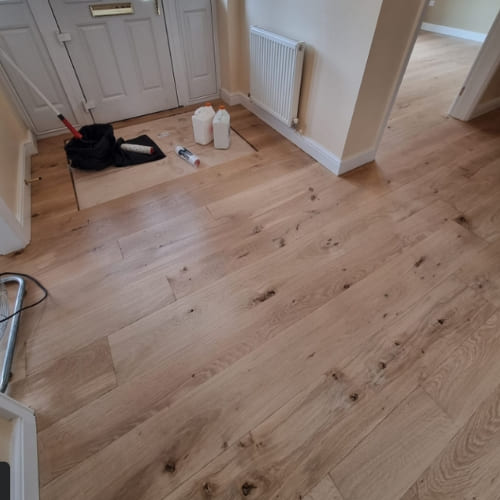
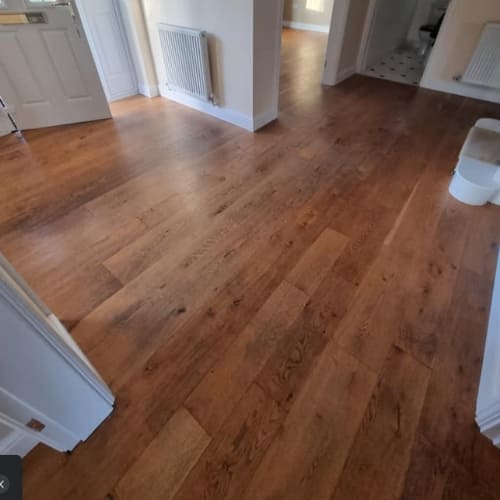

Difference Between Polyurethane and Lacquer
Durability and Protection
Polyurethane and lacquer offer commendable protection against everyday wear and tear. However, polyurethanes are more durable since they are resistant to moisture and chemicals that gives them an edge over other materials in environments that might be subject to spills or harsh cleaning agents.
Application and Ease of Use
Polyurethane requires a brush and is generally easier to apply due to its self-leveling properties and longer drying times but it might leave brush marks. On the other hand, lacquer needs a sprayer, which is more expensive but applies evenly. Lacquer’s quick drying time can sometimes make application challenging, as it requires careful and swift work to avoid uneven coats.
Coats/Layers
Applying several coats with lacquer is a straightforward process, allowing layers to be built up easily. In contrast, with polyurethane, additional time is needed for curing, followed by sanding to ensure a strong bond between successive coats. This distinction underlines the convenience of lacquer in the layering process.
Aesthetic Appeal
Lacquer often provides a more traditional, glossy finish that imparts rich depth to wood. On the other hand, polyurethane offers a wide range of sheens, including matte and satin, catering to both modern and classic aesthetics.
Environmental Considerations
Water-based polyurethane is considered more environmentally friendly due to its lower volatile organic compound (VOC) content than solvent-based lacquers. Water-based polyurethane emits fewer harmful fumes and has a milder odor during application.
Dry times
Polyurethane has a lengthier drying period, with water-based versions drying faster than oil-based ones. Lacquer is favored for its rapid drying, often within 10 minutes, while polyurethane can take hours. The quicker drying of lacquer allows for easier application of multiple coats compared to polyurethane.
Polyurethane vs lacquer cost
Cost comparison between polyurethane and lacquer depends on factors like brand, quality, and type. Lacquer is often more expensive due to its composition, but the exact cost varies depending on the specific type of product (either oil-based or water-based) and quantities.
How to Choose a Right Finish: Lacquer Vs Polyurethane for Different Surfaces
1. Dining Room Table:
For a dining room table that sees frequent use and potential spills, choose lacquer. Apply multiple coats to protect the wooden surface. Lacquer’s protective nature ensures the table withstands daily wear and maintains its lustrous appearance.
2. Furniture:
You can choose lacquer or polyurethane for furniture based on your priorities. If you’re aiming for a glossy finish and don’t anticipate heavy wear, lacquer could be ideal. However, if your furniture endures regular use or moisture exposure, polyurethane offers superior durability. Think about your furniture’s purpose and desired aesthetic to make the best choice.
3. Outdoor Projects:
Lacquer is great indoors, but not outdoors. When you put lacquer on wood outside, it penetrates into the wood and helps it handle adverse weather better. If you’re building an outdoor bench or deck, consider durable finishes like polyurethane.
4. Hallways and Entryways:
High-traffic areas demand durability. If you’re thinking about hallways or entryways, polyurethane is an excellent choice. This is because it can handle people walking and things rubbing against it without damage. Its tough finish holds up well to constant use and provides the longevity needed for frequently traversed spaces.
5. Tabletops:
Lacquer and polyurethane work for tabletops, but consider your priorities. Lacquer shields against water and heat, suitable for tabletops that encounter beverages and hot dishes. Polyurethane, though, requires extra care against heat but protects well against water damage.
5. Cabinets in Kitchens and Bathrooms:
Lacquer excels in moisture-prone areas. Its glossy finish enhances aesthetics and safeguards against water, stains, and scratches. In kitchens and bathrooms, where spills and humidity are common, lacquer ensures lasting beauty.
Final Words On lacquer versus polyurethane
In the polyurethane vs. lacquer debate, the choice ultimately comes down to the specific requirements and preferences of the project. Polyurethane offers robust protection and longevity, making it ideal for high-traffic areas. Lacquer, with its quick-drying properties and distinctive glossy finish, is well-suited to enhancing furniture and decorative pieces aesthetic appeal.
When making a decision, it’s advisable to consider factors like the application, the desired appearance, and the possible environmental conditions that will be considered. Whichever option you choose, both polyurethane and lacquer have proven their worth as reliable finishes for wood surfaces.
FAQS On Polyurethane Vs Lacquer
Is lacquer the same as polyurethane?
No, lacquer and polyurethane are different finishes. Lacquer is a fast-drying solvent-based coating that provides a glossy appearance, while polyurethane is a protective layer available in oil or water-based variants.
Is polyurethane a lacquer?
No, polyurethane is a distinct finish used to protect wood surfaces, while lacquer is another type of finish that adds gloss and protection.
Is lacquer oil-based?
Lacquer can be oil-based or water-based, offering various characteristics depending on the type.
What does lacquer do?
Lacquer adds aesthetic appeal and protection to surfaces, enhancing their look and durability.
Is lacquer better than polyurethane?
The choice between lacquer and polyurethane depends on the project’s needs. Lacquer offers quick application and glossy finishes, while polyurethane provides superior durability and wear protection.
Is lacquer or polyurethane better for furniture?
Polyurethane is often recommended for furniture due to its durability and protective qualities. It can withstand furniture surfaces’ wear and tear.
What is the hardest clear wood finish?
Polyurethane stands out as a robust and exceptionally durable choice for wood finishes. Polyurethane is renowned for being one of the toughest and longest-lasting wood finishes available.
Can you lacquer over polyurethane?
Yes, you can lacquer over polyurethane, but proper preparation and compatibility checks are crucial for good adhesion between the layers.

Martina Hitchcock
Martina Hitchcock is a versatile author with expertise in different fields. As a paint sprayer expert, she has in-depth knowledge of paint spraying techniques, tools, and equipment. Martina is also an experienced home remodeler who has worked on various projects, including kitchen and bathroom renovations, flooring installations, and room additions. Her knowledge of home improvement and remodeling is extensive, and she enjoys sharing her insights and tips with readers. You can follow her on Facebook.

